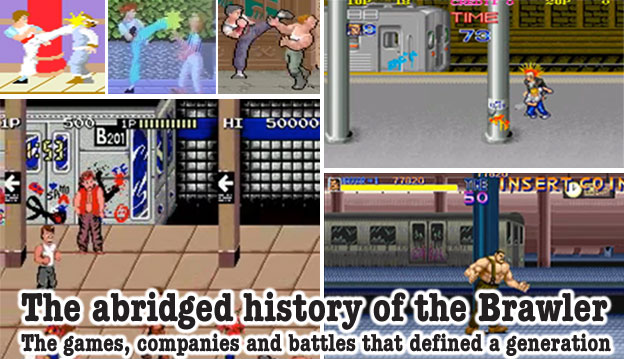
Konami came out swinging in 1991. Their first licensed title of that year was considered by many long-time Simpsons fans as the best videogame based on the animated series. I would be inclined to agree with them. Konami approached the series in the completely opposite direction than Data East did with Captain America and the Avengers. The show was just beginning to gain momentum, it was not the pop juggernaut that it became a few years later. Konami did not have to go out of their way to ensure it received any special treatment. Instead of simply licensing the series and throwing some random game together, or worse yet, ignoring the important Simpsons canon, Konami did a great deal of research and stayed completely true to the source material. They went so far as to capture the early artistic style of creator Matt Groening, whose fingerprints were all over the earliest seasons. Konami had applied a greater level of detail even than when they released the TMNT game which was impressive because at that point there was still not a tremendous amount of Simpsons animated material to draw from.
The game revolved around the kidnapping of Maggie Simpson by Mr. Burns. The Simpsons clan traversed the known Springfield universe to get her back, including a stop off at Moe's Tavern, the Springfield Discount Cemetery, Channel 6 and the Nuclear Power Plant. The game was filled with details pulled right from the show and plenty of hidden gags. Players were tempted to go near doors only to have them swing open and flatten the heroes. The same gag had been featured in Crime Fighters, also by Konami, a year before. Other gags involved not moving the joystick and watching the hidden animations and word balloons appear over the characters. To break up the monotony mini games were placed between the levels.
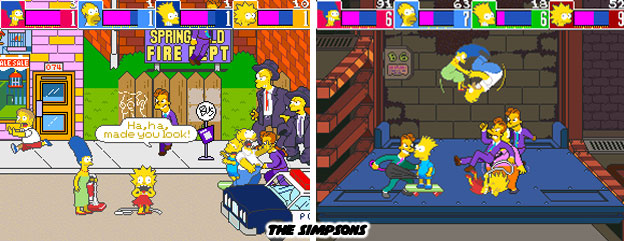
As far as brawling titles went the game had it all. Wave after wave of unique rivals, mostly goons hired by Mr. Burns, but also the rabbit characters from Groening's Bongo comics, wrestlers, robots and ninjas as well. There were also secret double-team attacks as well. If two characters stood side by side and the players did not move the controls then they would team up to do damage to opponents without getting hurt themselves. Homer could throw Bart at opponents, Marge and Homer could roll over opponents and Bart and Lisa would hold hands and run down opponents while yelling their lungs out (my personal favorite). The animation was great with plenty of nuances that followed the style of the show and didn't appear to have been designed or programmed by the Japanese.
Capcom was trying a multi-tiered approach to the brawler that year. They tried out different genres and artistic styles for the brawler. Two of which were medieval titles that came out the same year. King of Dragons was a brawler with RPG elements. Players could choose from one of several classes including the traditional Elf, Wizard and Dwarf. Characters fought off waves of orc's, goblins, dragons and other fantasy monsters.
The characters had weapons that could be "upgraded" by collecting treasures and defeating opponents. This meant for stronger attacks and vitality through the course of the game. These same elements were explored in the sister title Knights of the Round. Knights of the Round was a fantasy brawler as well. Instead of five character classes there were three main characters to choose from; King Arthur, Lancelot and Percival. They, and their opponents, were based on the legendary figures. The sprites were slightly larger than those from King of Dragons and more detailed. As the characters progressed and gained levels and experience their weapons and armor reflected the changes. If a player went from beginning to the end then they would have earned the best possible version of the weapons or armor. If a player decided to join a game in progress then they would begin at level 1 weapons and armor. The game offered no shortcuts to eager cheaters.

Knights of the Round and the King of Dragons were not Capcom's first attempt at sword and sorcery action games. A year prior they had released Magic Sword. It was a 2-D adventure game that had many of the same elements featured in both brawlers. Characters could earn weapon, armor and magic upgrades. They could even earn sidekicks to help with battles and those sidekicks could be upgraded as well. The three games were very fun to play and offered a unique take on the fantasy brawler. They were all far enough removed from Golden Axe as not to draw immediate comparisons yet were still as accessible. The games worked in the arcade and were able to be ported to the Super Nintendo home console quickly because they lacked the complexity or large sprites featured in the Simpsons arcade game. Capcom would see a tremendous potential in keeping their arcade efforts and home versions almost identical. In many cases they could charge people twice for playing the same game.

Both Konami and Capcom were experimenting with animation techniques and visual stylization in 1991. Both put forward games that featured original characters with cartoon elements.
Captain Commando, the game featuring the company mascot (CAPtain COMmando). The good Captain was joined by a trio of odd archetypes. The alien mummy Mack the Knife, the futuristic ninja Ginzu and the robot-piloting Baby Head.
The characters were silly and their opponents were over-the-top. The game was like a send up of the old superhero shows where a handful of heroes fought against impossible odds to save the planet. The game was fun but featured elements that were reminiscent of things explored by Konami the previous year. In one part of the game the main characters could jump into robot suits and set opponents on fire. This was similar to the robot suit that players could use against the alien queen at the end of Konami's Aliens game. Also a portion of the Captain Commando game featured the characters flying over the ocean on rocket powered hoverboards. This was not unlike the skateboard mechanic used in Konami's TMNT game.
Konami did not just meet the challenge laid out by Capcom, they exceeded it in many regards. The Simpsons was a runaway hit in the arcade, their other brawler was not as popular but it was equally fun. Sunset Riders was a brawling interpretation of the wild west. It featured four generic heroes, two of which fought with pistols and two of which fought with rifles. The four were on the search for outlaws and their bounties. The characters could walk along frontier towns, forests and trails, in some parts of the game they could even climb hand over hand on suspended rope bridges. Some of the levels featured the cast on horseback chasing down opponents. The game was filled with as many hidden animations if not more than the Simpsons. Players that happened to pass an open door could run into the room and get kissed by a girl for extra health. The characters could also interact with the environment. They could shoot ropes holding barrels down onto opponents, take hold of gatling guns and shoot up to fortifications and swing on chandeliers while shooting at bosses inside a saloon.
Sunset Riders was not the first attempt for Konami to get into the western. In 1986 they released a game called Ironhorse which played somewhere in between a brawler and Castlevania, which they also created. Ironhorse was set entirely within a stolen train and the main character had defeat wave after wave of opponents as he ran towards the engine. Ironhorse was nothing special, especially when compared to Sunset Riders. The game was a caricature of the wild west, further distilled by Japanese animé aesthetics. Despite being entirely based on gunplay the title was cartoony and lighthearted. The title was definitely not politically correct. Good guy and bad guy archetypes were brightly painted interpretations of history. The Mexican character for example, Cormano, wore a pink sombrero and poncho. Saloon girls entertained our heroes with a flirty can-can, in the opening credits the hero Billy could clearly be smoking a cigarette and the Native American boss character "Chief Scalpem" and his tribe were as stereotypical as the studio could get. Needless to say a game like this would have never been released by a US developer. Yet remember that the Japanese and most other Asian countries do not share the same cultural perceptions. Many countries on the other side of the Pacific did not have a Civil Rights Movement, they did not change policy or social customs because of the minority. What some people in the USA would consider stereotype they might consider entertainment. If anything Sunset Riders was pandering to the same crowd that grew up on westerns in the USA.
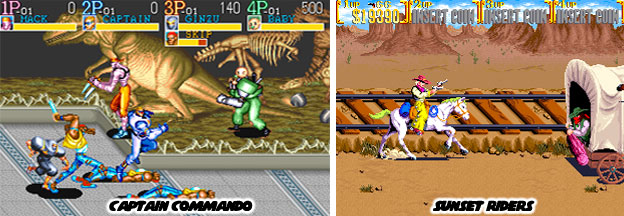
Despite its skewed take on the west the game was still highly memorable and playable. The levels were familiar versions of western locations. Characters battled scores of bandits not only on horseback but also while riding atop a train, while raiding a fort and even running on top of bulls during a stampede. The levels were an amalgamation of cool movie moments that never were just as the cast was made up of familiar faces that were brand new. The boss fights were intense but not outright cheap and the music kept a familiar guitar twang throughout. In fact there were several digitized audio files that worked well in the game, none more than the dialogue between the characters and bosses. After the very first boss, Simon Greedwell was defeated he took a tumble from the balcony of his business and said with a Southern drawl "bury me with my money." That overly dramatic line would stick with my brothers. 20 years later whenever one of us said that line we would laugh and wonder why there was never a sequel.
Most brawling games rarely saw a sequel, the few ones that came out were mostly released on consoles. Double Dragon had a couple of arcade sequels which, depending on whom you asked, were of diminishing quality. Konami did develop a sequel that was hands down better than the original title. Vendetta was a sequel to Crime Fighters, the 4-player brawler from 1989. The original game had the bad luck of being released the same year as Final Fight. Konami got buried by Capcom's urban brawler. A few years later they came back with an updated game which met, and in some ways, topped Final Fight. Now I don't want to say anything too outlandish because it appears that 99% of the arcade vets remember Final Fight but only 1% remember Vendetta. If it were great then surely it would have been enshrined in the arcade hall of fame. I certainly would not want to offend the 99% but the game definitely deserves a spot in the top 10 list of all-time brawlers.
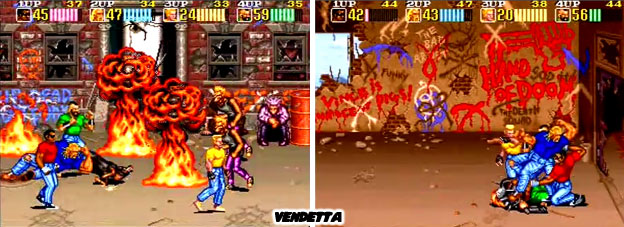
Vendetta was a trip back to the elements that made the brawler so appealing, especially to young men. To audiences it was a better version of Double Dragon with support for 4-players. Then they could dig deeper and find all sorts of advances to the genre. Players could punch, kick and combo attack opponents just as they could in other urban based brawlers. They could also grab and strike as well as throw opponents, that was nothing new. However the moves that characters had in this game were unique and greatly rewarding especially for those that played in a group. Players could sneak up behind opponents, grab them in a full nelson and let teammates punch them. Players could also strike opponents on the ground. Best of all none of the four playable characters shared the exact same move set; one kicked, one punched, one dropped a knee and one dropped elbows on the prone opponents. Up until that point most brawling games had characters that played fair and let gang members get up before they could be hit again. The bad guys fought dirty and heroes never could in other games. Vendetta was a counter to that logic. If a bad guy could pull a knife or gun on the heroes then why should they hold back? Players could smack into opponents with a running clothesline, throw molotov cocktails, pick up dropped shotguns and swing nail bats with reckless abandon.
There was nothing more satisfying than playing in a group and experiencing the mayhem that was Vendetta. Throwing opponents off of elevated platforms, hitting them with a sack of cement and watching them go blind for a moment before following up with a sucker punch. It satiated the bloodlust of the teenage mind by allowing it to fulfill the violent fantasies that were denied in other brawlers. It predated the design and chaotic atmosphere that made State of Emergency one of my favorite games of all-time. However it was a game that wast best enjoyed with a group of players, the best mechanics in the game were dependent on having other players team up on the rival gang. Arcade players rarely ran in packs, let alone played the same game at the same time. Final Fight could be enjoyed as a solo experience or with a team, that was the balance that Konami lacked here and why Vendetta was not as well remembered. The other reason why it might have been overlooked was because it was a retelling of the original Crime Fighters plot. Except instead of kidnapping several women this time it was one girl that was kidnapped. The damsel in distress was starting to become a stale plot.
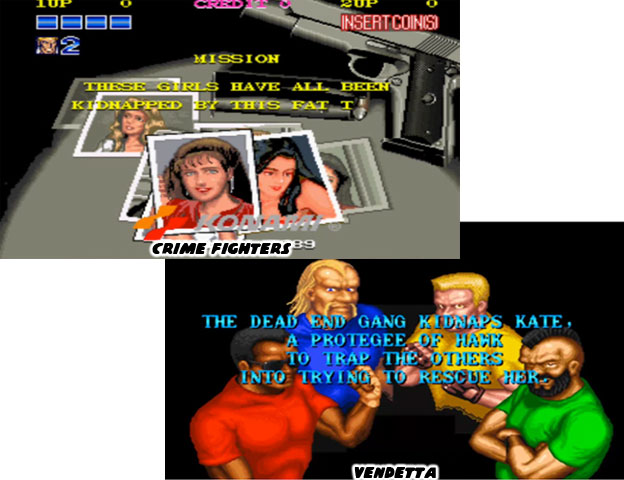
Vendetta was a spectacle, every level tried to outdo the last and even the final level consisted of taking on all of the bosses in a battle royal (just as in the original Crime Fighters). The gang characters were not quite typical with the occasional masked, chubby voodoo brawler or whip-cracking dominatrix chasing down the heroes. The game even allowed players to fight off rabid doberman pinschers (much to the chagrin of animal lovers). The bosses were typical exaggerated gang archetypes. Leather-clad tough guys and suit wearing kooks that could have fallen out of a comic book. Those bosses and even the heroes themselves were actually a Japanese interpretation of US pop culture. In the original Crime Fighters the four main characters looked identical with only the color of their pants separating the brawlers. In the sequel there were four distinct characters, members of the Cobras gang. The black ex-boxer Blood (wearing red mind you), the former pro wrestler Hawk (which looked just like Hulk Hogan), Boomer the blonde karate fighter and Sledge the ex-military convict (who looked like a white version of Mr. T.) made up the playable characters. The crew was fighting off the menace of the Dead End gang, which did sound very intimidating, and featured characters like Buzzsaw Bravado, the Rude Bros. and the leader Faust.
It was always interesting to see how Western pop culture or even sub-culture was assimilated into gaming design. Hard rock and heavy metal had always maintained a certain level of popularity in Japan. The characters Poison, Roxy, Axel and Sodom from Final Fight were inspired by the metal scene from the late 80's and early 90's. In Vendetta it was a bit of US wrestling culture that took the lead. Mr T and Hulk Hogan were old favorites from TV that had appeared in Japan following their pop explosion in the 80's. A lesser-known wrestler by the name of Bruiser Brody had made quite an impression on the Japanese during his various tours. A version of the character was featured in Vendetta, dubbed the Missing Link (not to be confused with another wrestler actually called the Missing Link). The videogame version was a crazed fighter not far removed from the actual wrestler and his gimmicks.

It could be argued that the brawler evolved from Japan pandering to Western markets. Kung-Fu Master and Karate Champ were groundbreaking games but in order to appeal to the US arcade market the publishers had to reflect the culture. Double Dragon succeeded because it was set in a pseudo New York. Almost every successive brawler from that point on was steeped in western culture. The Simpsons, Aliens and TMNT were popular licenses. Sunset Riders was a take off on the TV western. Even fantasy brawlers, Knights of the Round and King of Dragons were based on western rather than eastern mythology. Final Fight and Vendetta were superior versions of Double Dragon with hopefully enough western cultural references to keep gamers putting in their quarters. Both Konami and Capcom made sure that 1991 was a very good year for players. The rest of the industry would continue pushing the genre forward, releasing wave after wave of new takes on the genre. We shall explore these in the next blog. As always if you enjoyed this blog and would like to sponsor me please visit my Patreon page and consider donating each month, even as little as $1 would help make better blogs and even podcasts!

No comments:
Post a Comment